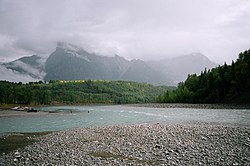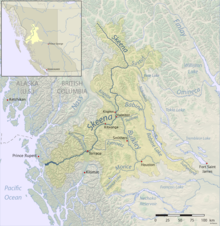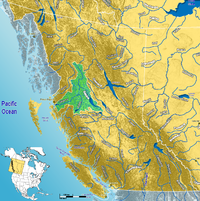Skeena River
| Skeena River | |
|---|---|
 The Bulkley River (left) flowing into the Skeena River (right) near Hazelton | |
 Skeena River watershed with tributaries | |
| Location | |
| Country | Canada |
| Province | British Columbia |
| City | Terrace |
| Physical characteristics | |
| Source | Spatsizi Plateau |
| • coordinates | 57°9′6″N 128°41′29″W / 57.15167°N 128.69139°W |
| Mouth | Pacific Ocean |
• location | Chatham Sound |
• coordinates | 54°8′15″N 130°5′40″W / 54.13750°N 130.09444°W[1] |
• elevation | 0 m (0 ft) |
| Length | 570 km (350 mi) |
| Basin size | 54,400 km2 (21,000 sq mi)[2] |
| Discharge | |
| • location | mouth[2] |
| • average | 1,760 m3/s (62,000 cu ft/s)[2] |
| Basin features | |
| Tributaries | |
| • left | Sustut River, Babine River, Bulkley River, Zymoetz River |
| • right | Kitwanga River, Lorne Creek, Kitsumkalum River |
The Skeena River is the second-longest river entirely within British Columbia, Canada[3] (after the Fraser River). Since ancient times, the Skeena has been an important transportation artery, particularly for the Tsimshian and the Gitxsan—whose names mean "inside the River of Mist" ,and "people of the River of Mist," respectively. The river and its basin sustain a wide variety of fish, wildlife, and vegetation, and communities native to the area depend on the health of the river. The Tsimshian migrated to the Lower Skeena River, and the Gitxsan occupy territory of the Upper Skeena.
During the
Geography
The Skeena originates south of the Spatsizi Plateau Wilderness Provincial Park in north western British Columbia, forming a divide with the Klappan River, a tributary of the Stikine River. It flows for 570 km (350 mi)[4] before it empties into Chatham Sound, Telegraph Passage and Ogden Channel, east of the Dixon Entrance, all part of the Pacific Ocean. The Skeena drains 54,400 km2 (21,000 sq mi) of land with a mean annual discharge of 1,760 cubic metres per second (62,000 cu ft/s).[2]
Course

The Skeena River originates at the southern end of
Tributaries

Partial listing from Fisheries and Oceans Canada[5]
Upper Skeena
- Bear River, Johanson Creek, Mosque River, Shilahou Creek, Slamgeesh River, Sustut River
Middle Skeena
- Babine River, Boucher Creek, Buck Creek, Bulkley River, Comeau Creek, Cullon Creek, Date Creek, Deep Canoe Creek, Fulton River, Harold Price Creek, Kispiox River, Kitseguecla River, Maxan Creek, McCully Creek, McQueen Creek, Morice River, Nangeese River, Nanika River, Nilkitkwa River, Pinkut Creek, Richfield Creek, Shegunia River, Simpson Creek, Stephens Creek, Suskwa River, Sweetin River, Toboggan Creek
Lower Skeena
- Alwyn Creek, Big Falls Creek, Cedar Creek, Coldwater Creek, Lakelse River, Lean-To Creek, Limonite Creek, Magar Creek, Moonlit Creek, Salmon Run Creek, Scotia River, Sockeye Creek, Spring Creek, Star Creek, Thomas Creek, Trapline Creek, White Creek, Williams Creek, Zymagotitz River, Zymoetz River
Wildlife
The Skeena supports a wide variety of fish and wildlife. The British Columbia Ministry of the Environment, through BC Parks, has designated a number of Ecological Reserves along the course of the river.[6]
Fish
The Skeena is well known for its
The following types of
- Chinook salmon, sometimes known as king, Tyee, spring, Quinnat, tule, or blackmouth salmon.
- Chum salmon, sometimes known as dog or calico salmon.
- Coho salmon, sometimes known as silver salmon.
- Pink salmon, sometimes known as humpback salmon.
- Sockeye salmon, sometimes known as red salmon or blueback salmon.
Other anadromous species:
- Steelhead, anadromous form of rainbow trout
Bears
The rare
History
Indigenous peoples
The Skeena River watershed is the ancient homeland of the
During the
Fur trading
The
Riverboats
While
SkeenaWild Conservation Trust
In 2007 SkeenaWild Conservation Trust was formed to promote projects and initiatives by conservationists, First Nations in Canada, and local communities to protect the natural sustainability of the Skeena watershed and its wild salmon ecosystems. The organization has a large payroll and is dependant on convincing the public that salmon are in crisis. [13][14] One of SkeenaWild's main goals is to develop and implement a strategy for long-term stewardship of forest carbon in the Skeena watershed.[15]
See also
- List of rivers of British Columbia
- Steamboats of the Skeena River
- List of ships in British Columbia
- Gitxsan Language
- [2]
- [3]
- [4]
References
- ^ "Skeena River". BC Geographical Names.
- ^ ISBN 978-0-12-378577-0. Retrieved 5 August 2013.
- ^ British Columbia.com. "Skeena River". Retrieved 2008-01-23.
- ^ Map of Skeena River Archived 2004-12-05 at the Wayback Machine
- ^ Water Systems with Chinook, Fisheries and Oceans Canada, URL accessed 6 November 2006
- ^ Skeena River Ecological Reserve [1].
- ^ Skeena River - Four Seasons of Skeena Fishing, http://www.bcadventure.com, URL accessed 6 November 2006
- ^ The Skeena River Archived 2006-08-28 at the Wayback Machine, Z-Boat Lodge River Guides, URL accessed 6 November 2006
- ^ Salmon - Sockeye - Skeena River: Fishery Outlook / Management, Fisheries and Oceans Canada, URL accessed 11 November 2006
- ISBN 978-0-295-97837-6. Retrieved 10 February 2021.
- ^ Lange, Greg. "Smallpox Epidemic of 1862 among Northwest Coast and Puget Sound Indians". HistoryLink. Retrieved 8 February 2021.
- ^ ISBN 0-9683026-0-2
- ^ "Our Story". SkeenaWild Conservation Trust (skeenawild.org).
- ^ "Wild Salmon Center, in coalition with SkeenaWild". wildsalmon.org.
- ^ Pojar, Jim (February 2019). "Forestry and carbon in BC" (PDF). Report prepared for: SkeenaWild Conservation Trust, Terrace, BC and Skeena Watershed Conservation Coalition, Hazelton, BC.
